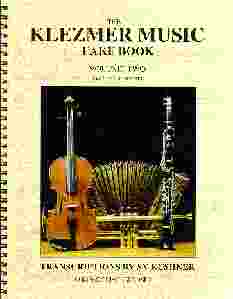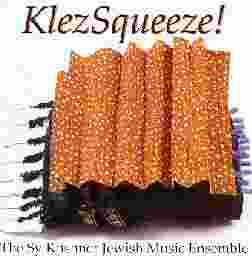
Double Review
1) Music Book and CD:The Klezmer Fake Book, Volume II

The Klezmer Fake
Book/Compact Disc
Volume Two
for C Instruments
Contents:
A Vivat far di Mekhatunim
Der
Khusid Geyt Tantsn
Drohibitsher Khusid
Flaskadriga
Fun
Tashlikh
Title Unknown
Rumanian-Bulgarish
Der Muzinikal
Rusishe Sher
The Philadelphia Sher
Shulem's Bulgarish
Grichisher Tants
Terkish-Bulgarish
Sadegurer Khusedl
Tate
Ziser
Zeydn's Tants
Russian Sher
Vi Tsvey iz Naftule der
Driter
Di Rayze Nukh Amerike
Baym Shotzer Rebbe Oyf Shabes
total time: 65:50
published in 1996
KlezSqueeze!

Sy Kushner,
accordion
Martin Confurius, string bass
Alexander Fedoriouk,
tsimbl
Ken Maltz, clarinet
Program:
Sadeguruer Khusel
Drohibitsher Khusid
Der Heisser - Tartar
Dance
The Philadelphia Sher
Lustige Khasidm
Shulem's Bulgarish
Odessa-Bulgar
Di Rayze Nukh Amerike
Fun Tashlikh
Dovid'l
Bazetst Di Kale
Tants a Freilach
Baym Shotzer Rebbe Oyf Shabes
Naftule Shpilt Far Dem Rebn
Nor Gelebt, Nor Gelakht
Zeydn's
Tants
Russian Sher
total time: 59:17
Released in 1996
Review number and date: Nos. 55 & 56, July 1997
label: Bon Air Recordings
61 Bon Air Avenue
New Rochelle,
NY 10804
USA
Tel. and Fax: 914-632-7793
sykushner@aol.com
Review by Henry Doktorski:
When I first received The Klezmer Music Fake Book Volume Two (with accompanying CD) in my mail, my first reaction was "Wow!"
This work is, in my opinion, a significant musicological contribution to students, performers, scholars and other lovers of Klezmer music. (The cover photo -- of fiddle, clarinet, trumpet and antique accordion -- is artistic and very attractive.)
The CD features some of the great soloists and ensembles of
Jewish music of the early twentieth century, such as the Ukrainian State
Jewish Instrumental Ensemble (1930), Al Glaser's Bukovina Kapelle with
clarinetist Dave Tarras (1939), the Abe Elinkrig Orchestra (1915),
accordionist Mishka Tsiganoff (1929), clarinetist Naftule Brandwein
(1922), accordionist Max Yenkowitz with tsimbalist Goldberg (1913), the
Abe Schwartz Orchestra (1920), the State Ensemble of Jewish Folk Music of
the Ukrainian Soviet Socialists Republic (1930) and others.
The CD is a re-release of an assortment of 78 LP discs -- some
recorded nearly eighty years ago! -- and understandably includes some
nasty scratches and record noise. The accompanying music book gives
fairly accurate transcriptions -- in lead sheet format (melody and chords)
-- of the music on the CD. Sy Kushner's transcriptions were undertaken
with painstaking care; he even noted the krechtz (also known as boip) with
a special marking (^) in the score.
Mr. Kushner, who began accordion lessons at the age of nine and in
1964 released his first recording: "The New Jewish Sound" by The Mark 3
Orchestra and Singers. He has performed at venues including the World's
Fair, New York's Town Hall and Carnegie Hall. He became known as a
leading innovator in contemporary Jewish music by his progressive uniting
of Klezmer and rock music. Today -- according to the CD booklet notes --
he is known as one of the foremost Klezmer accordionists in the United
States.
Mr. Kushner wrote in the Introduction: "There are limitations
in transcribing music. The feeling and style of the music cannot be
captured in print. It is therefore most important to listen to the
original recordings of the music transcribed for this book. . . This
book, along with the compact disc, represents a commitment to help
preserve a rich Jewish music culture forgotten for forty years."
I congratulate Sy Kushner for his important role in the re-discovery
of Jewish folk music and I heartily recommend this book/CD for all lovers
of Klezmer music. The book is also printed for Bb instruments.
My reaction to the second CD, KlezSqueeze!, was less
enthusiastic.
Granted, there is a lot of fine playing on the album (tsimblist
Alexander Fedoriouk deserves special mention) and the arrangements
(including the variations of the accordion stops or registrations) were
interesting, but overall I felt that, for some of the time at least, the
accordion was not played very expressively and occasionally Kushner's
technique was less than adequate, as was apparent in the sloppy ascending
chromatic runs in Odessa Bulgar.
However, my primary complaint is that the sound of the accordion
overpowered the ensemble. Listen to the first four tracks: they all
feature the accordion and they all basically sound the same (with few
exceptions); I detected hardly any dynamic variation to speak of. Even
when the tsimblist had a solo, the accordion distracted my attention from
(and seemed to minimize) Fedoriouk's fine playing.
In contrast, track number five -- Lustige Khasidm -- (which features
clarinetist Ken Maltz) makes a huge difference: this cut features some
absolutely superb musicianship with extremely tasteful balance. Why? The
accordion tacets for the first minute or so, and when it finally appears,
it enters quietly and sensitively and does not dominate the other
musicians. This is beautiful chamber music. The ending is extremely
satisfying, as the motif of the theme is repeated one last time in the
lower register.
Despite my criticisms, several tracks are outstanding (by any
standard) and deserve special mention. Track number six -- Shulem's
Bularish -- features Kushner's accordion played with finesse and delicacy
in the rubato section and with great verve and gusto in the 2/4 dance
section. In Fun Tashlikh the rich (and often humorous) bassoon register
of the accordion is featured and both the tsimbl and string bass get in
some great solo licks.
In contrast, track number five -- Lustige Khasidm -- (which features
clarinetist Ken Maltz) makes a huge difference: this cut features some
absolutely superb musicianship with extremely tasteful balance. Why? The
accordion tacets for the first minute or so, and when it finally appears,
it enters quietly and sensitively and does not dominate the other
musicians. This is beautiful chamber music. The ending is extremely
satisfying, as the motif of the theme is repeated one last time in the
lower register.
Despite my criticisms, several tracks are outstanding (by any
standard) and deserve special mention. Track number six -- Shulem's
Bularish -- features Kushner's accordion played with finesse and delicacy
in the rubato section and with great verve and gusto in the 2/4 dance
section. In Fun Tashlikh the rich (and often humorous) bassoon register
of the accordion is featured and both the tsimbl and string bass get in
some great solo licks.
| About The Free-Reed Review |
| Invitation to Contributors / Submission Guidelines |
| Back to The Free-Reed Review Contents
Page |
| Back
to The Classical Free-Reed, Inc. Home Page |